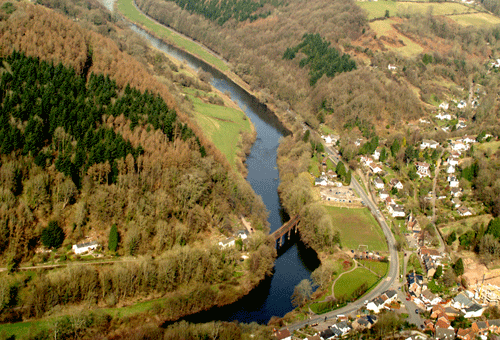Lower Wye Valley
040 Lord's Grove Woodland

HLCA 040 Lord's Grove Woodland
Area of Ancient Woodland: other broadleaf woodland; relict industrial archaeology: quarries; communication features (including industrial Rail). Back to map
Historic Background
The historic landscape area of Lord's Grove Woodland is an area characterised by ancient woodland and that runs in a long narrow strip along the west-facing hillside, which forms the side of the Wye Valley at this point. It is bounded by the surrounding fieldscape to the east, and to the west by the narrow transport corridor running along the bank of the River Wye. Historically, the area fell within the parish of Dixton.
Little historic background is available on this area; comparison of recent mapping and the tithe map of Dixton Parish (1844) indicates that there has been little change in the general extent of the woodland. There is currently no known evidence for activity in the area predating the post-medieval period, when communication and transport routes were cut through the area in the nineteenth century. The first was the Monmouth Railway or Tramroad, authorised by an Act of 1810, this was completed in 1812 (Coates 1992). It ran from Howler's Slade, in the Forest of Dean, through Coleford to Monmouth, and the line cuts through the woodland, before separating into two branches to the south, just outside the boundary of the area. Later the construction of the adjacent Monmouth to Chepstow Turnpike road (1829) and the Wye Valley Railway in the 1860s and 70s had a slight impact on the eastern edge of the area (tithe map (1844 and First Edition OS).
Historic Landscape Characteristics
Lord's Grove Woodland is primarily characterised almost entirely by semi-natural ancient woodland; it comprises a long narrow strip of woodland extending south along the west-facing side of the hill above the Wye Valley north of Redbrook. The other main characteristic of the area is provided by the transport links, which run through it; namely the line of a former industrial tramway runs from north to south through the area, this is a branch line of the Monmouth Tramroad, which was opened in 1812 and ran between Monmouth and Howler's Slade at Coleford. Although dismantled by the time of the publication of the First Edition OS map (1887, 1890), the line of the tramway can be seen on these maps and is currently a track. This tramway later served the Redbrook tinplate works via the 'Redbrook Incline Overbridge', (PRN 02195g, NPRN 34994, LB 85227, SAM MM 203), which falls within the adjoining area.
Additionally, the A466/Turnpike road (Redbrook Road) and the line of the former Wye Valley Railway define eastern boundary of the area. Further communication links in the form of winding lanes also run through this area, including Wyesham Lane, leading to Duffield's land and Redbrook.
The industrial archaeology is another characteristic comprising a number of small quarries in the north of the area (including NPRN 40606) which are in existence from at least 1887/1890 and depicted on First Edition OS maps. These quarries all lie in close proximity to the transport links that run through the area; the route of the Monmouth Tramroad, and the lane leading to Cockshoot Ash Barn, and may have been associated with the construction of these features.